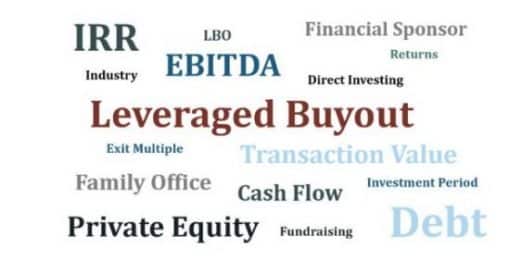Have you considered your business’s exit strategy? If this is the case, you’ve certainly examined a variety of alternatives, ranging from initial public offerings to liquidation.
However, if you’re like many business owners, closing your doors permanently was not your intention when you established your firm. You’ve worked diligently and deserve to get a reward. If you’re ready to sell and pursue another interest, a leveraged buyout model may be an option. Let’s see how the leveraged buyout LBO works and also see some examples of successful and unsuccessful buyouts.
What is a Leveraged Buyout (LBO)?
A leveraged buyout (LBO) is a transaction in which a business is acquired primarily via the use of debt. Typically, these transactions occur when private equity (PE) firm borrows the maximum amount possible from a variety of lenders (up to 70% or 80% of the purchase price) and then funds the remainder with their own equity.
Why do private equity firms employ such a high level of leverage?
Simply expressed, the use of leverage (debt) increases the private equity firm’s expected returns. PE businesses can obtain a high return on equity (ROE) and internal rate of return (IRR) by investing as little of their own money as feasible. Given that private equity firms are compensated on the basis of financial returns, the use of leverage in an LBO is important to obtaining the IRRs required by the PE firm (typically 20-30 percent or higher).
While leverage boosts equity returns, it does so at the expense of risk. By securing numerous tranches of financing to a running company, the private equity firm dramatically increases the transaction’s risk (which is why LBOs typically pick stable companies). If cash flow is constrained and the company’s economy suffers a downturn, they may be unable to service the debt and may be forced to restructure, thus eliminating all returns to the equity sponsor.
What type of business is a good candidate for a leveraged buyout?
Generally, established, stable, non-cyclical, and predictable businesses are suitable candidates for leveraged buyouts.
Given the amount of debt that the corporation would incur, it is critical that cash flows are predictable, with strong margins and relatively minimal capital expenditures. This consistent cash flow helps the business to readily service its debt.
How does a Leveraged Buyout Model (LBO) work?
The leveraged buyout study begins by developing a standalone financial model for the operating firm. This entails forecasting five years into the future (on average) and computing the final period’s terminal value.
The research will be presented to banks and other lenders in order to get the maximum amount of debt possible in order to optimize returns on equity. After determining the amount and rate of debt financing, the leveraged buyout model is updated and the final terms of the contract are established.
After they complete the acquisition, the task of adding value to the business begins, as the PE firm and management must expand the top line, reduce costs, pay down debt, and finally realize their return.
Steps Involved in a Leveraged Buyout:
- Create a financial forecast for the prospective client’s business.
- Connect the three financial statements and compute the business’s free cash flow.
- Create schedules for interest and debt.
- Calculate the credit metrics to determine the transaction’s leverage capacity.
- Calculate the Sponsor’s free cash flow (typically a private equity firm)
- Then calculate the Sponsor’s Internal Rate of Return (IRR).
- Analyze for sensitivity
Financial Model of Leveraged Buyout LBO
The financial model can become pretty complicated when it comes to leveraged buyout transactions. The additional complexity stems from the following distinct characteristics of leveraged buyouts:
- Excessive leverage
- Multiple debt tranches
- Bank covenants can be complicated.
- The Issuance of Preferred Stock
- Compensation for management equity
- Targeted operational improvements within the business
Additonal Reasons For A Business Owner To Consider A Leveraged Buyout
#1. To transform a public company to a private one
If you run a publicly traded firm, you can utilize a leveraged buyout to consolidate public shares and sell them to a private investor. The investors will subsequently control a majority or all of your business and will carry the transaction’s debt liability. For instance, an LBO is advantageous if the business requires repackaging and reintroduction to the market following marketability modifications. When a firm reenters the market through an initial public offering (IPO), it might do so with fanfare, reigniting public interest in the company.
#2. To dismantle a large company
Numerous business owners have employed efficiency measures to increase their profitability and appeal to prospective purchasers. However, some organizations become so enormous and inefficient that it becomes more advantageous for a buyer to break them up and sell them as a succession of smaller companies via a leveraged buyout.
Typically, these individual sales are sufficient to repay the loan used to acquire the business. This may be an excellent alternative if your business has many target audiences for diverse items. A leveraged buyout of this type can then provide smaller companies with a greater opportunity to expand and differentiate themselves than they would have had as part of an inefficient conglomerate.
#3. To improve an underperforming business
If an investor feels your business will eventually be worth far more than it is now, a leveraged buyout may be a viable alternative. The investor would assume the debt in the expectation that by remaining invested in the business for a specified period of time, the company’s value would improve, allowing them to repay the debt and earn a return. In this sort of leveraged buyout, the business owner wishes to quit before the company becomes successful, but without jeopardizing future profits. Taking the LBO proceeds from the purchaser enables you to capture a portion of that profit now, allowing you to focus on other endeavors.
#4. Purchase of a Competitor
Another frequent instance of a leveraged buyout is when a smaller business seeks to be bought by a larger competitor. This enables the smaller business to develop significantly and can assist them in acquiring new clients and scaling more quickly than they could without the purchase. Typically, the acquiring firm will retain your key personnel, so you won’t have to worry about losing the team you carefully selected. This can be an effective strategy for enlisting additional investors and experienced leaders and leveraging peer elevation.
If you wish to stay with the company, you can take a previously underperforming company to new heights with a more strong and diverse staff in place. Many business founders sell their firm through a leveraged buyout but continue to work as consultants to maintain relationships and assist the business in growing. Other business owners use an LBO to entirely abandon their current venture in order to seek one that satisfies their passion as well as their profitability.
Types of Leveraged Buyouts
To fully address the question, “What is a leveraged buyout?” we must first recognize that there are multiple distinct forms of LBOs, each of which is appropriate for a particular situation.
#1. Management Buyout (MBO)
In a management buyout, the present management team of the business acquires the business from the current owner. MBOs are frequently preferred by business owners who are retiring or if a majority shareholder wants to exit the company. They’re also advantageous for huge corporations looking to divest units that are underperforming or aren’t critical to their strategy. The buyers benefit financially from the success of the business more than they would if they remained employees.
Management buyouts provide a number of advantages, the most significant of which is operational continuity. When the management staff remains constant, the owner can anticipate a simpler transition and continued profitability.
#2. Management Buy-In (MBI)
On the surface, a management buy-in appears to be identical to a management buyout– but there are significant distinctions. External investors acquire the business and then replace the management team, board of directors, and other key individuals with their own representatives. MBIs frequently emerge when a business is undervalued or operating poorly.
Management buy-ins lack the stability associated with management buyouts. Indeed, MBIs frequently generate instability by replacing entire teams. However, MBIs do present an exit option for owners seeking retirement or who are in over their heads – and, when handled properly, they may be an excellent financial opportunity for the buyer.
#3. Secondary Buyouts
As the name implies, a secondary buyout is a buyout of a buyout. How it works is as follows: A private equity sponsor acquires control of a business through a leveraged buyout. Rather than reselling it to the public, as in a regular LPO, they then sell it to another enterprise. This enables the seller to exit the business entirely, providing them with immediate liquidity and a clean split.
Secondary buyouts benefit the buyer since they can then enhance the firm and resell it to the public at a better price. Additionally, they are beneficial for enterprises that operate in a highly specialized field, are small, or have strong cash flows but slow growth. Typically, these types of businesses are unattractive to public stock investors.
Benefits of Leveraged Buyouts
LBOs clearly benefit the buyer: they spend less of their own money, earn a larger return on investment, and assist in turning around businesses. They get a higher return on equity than in other buyout scenarios since they may finance the transaction using the seller’s assets rather than their own. Additionally, an LBO can reduce a business’s taxable income, allowing the buyer to take advantage of previously unavailable tax benefits.
What is an LBO and why would a seller pick one? One of the primary benefits of a leveraged buyout is the ability to sell a business that may not be performing at its peak but still generates cash and has the potential for growth. If a leveraged buyout strengthens a company’s market position – or even saves it from disaster – shareholders and employees profit. If the buyer is current management, employees gain from executives who are now more invested in the business as a result of their increased stake.
Additionally, a leveraged buyout enables groups such as employees or family members to acquire a business when the present owner retires, which can result in increased participation. Finally, if the target company is privately held, the seller may benefit from tax benefits associated with the LBO.
Examples of Leveraged Buyout
To gain a true understanding of leveraged buyout, you can examine examples of both successful and unsuccessful LBOs.
#1. SAFEWAY
One of the major examples of a leveraged buyout is the 1986 Safeway purchase, which was completed by Kohlberg Kravis Roberts (KKR) for a price of $5.5 billion. Safeway’s board of directors agreed to avert a hostile acquisition by Dart Drug’s Herbert and Robert Haft. The acquisition was financed mostly through debt and an agreement by Safeway to transfer some assets and liquidate underperforming shops. When Safeway went public in 1990, KKR profited over $7.3 billion on their initial investment of about $129 million.
#2. PETSMART
PetSmart’s $8.7 billion acquisition in 2014 is one of the greatest examples of leveraged buyouts. BC Partners, a British buyout firm, believed they could increase the company’s market share by leveraging previously underutilized online platforms. They acquired Chewy.com in 2017 and floated it on the stock market in 2019, raising approximately $1 billion.
#3. HOTELS HILTON
In economic downturns, leveraged buyouts can be profitable. Consider Blackstone’s LBO of Hilton Hotels in 2007 — just prior to the financial crisis. The economy tanked, and travel took a particularly harsh impact. Although Blackstone initially lost money, it was able to survive by focusing on management and debt restructuring. In 2013, Blackstone raised $12 billion in a public offering. Today, it is one of the most successful leveraged buyouts in history.
#4. MACY’S
Not all examples of a leveraged buyout have been successful. They face a high risk of failure due to their high debt-to-equity ratios. Macy’s is one of the most notable examples of a leveraged buyout gone bad. In 1985, Macy’s executives orchestrated the largest leveraged buyout in history. Financial analysts believed it would benefit the company – but it resulted in the accumulation of debt that the company was unable to repay. Macy’s filed for bankruptcy in 1992, with a $6 billion debt load. They gradually recovered, enjoying profitability for several decades until experiencing new difficulties – this time unrelated to leveraged buyouts.
Marketing your Business as a Leveraged Buyout
Are you considering selling your business via a leveraged buyout? If your business’s balance sheet is positive, you’re on the right route. This implies that you have tangible assets, adequate working capital, and positive cash flows. Possessing a positive balance sheet increases the likelihood of lenders lending to you.
Firms pursuing leveraged buyouts often seek proven management and a diverse, loyal customer base. They’ll be looking for ways to immediately decrease expenses, whether through the sale of non-core assets or the creation of synergies. Your business does not have to be performing optimally to be a strong candidate for a leveraged buyout. Businesses that are underperforming due to an industry slowdown or poor management but still have a strong cash flow are also attractive candidates for LBOs. Investors may sense an opportunity to improve the business’s efficiency and profitability and hence be interested in acquiring it.
Summary
Making the decision to pursue a leveraged buyout of your business is not a trivial matter. You must determine why you established the firm in the first place and whether you have accomplished the objectives you set. How will you feel after selling? Do you have a strategy in place for your next effort, or, if you’re retired, do you have sufficient funds in the bank or investments to fund the wonderful life you seek in your golden years?
Finally, if you’re wondering, “What is a leveraged buyout and is it right for my business?” ,” you may benefit from consulting with a business coach who can assist you in considering all possible outcomes and making the best choice for you and your firm. A business coach can evaluate the proposition objectively and without the emotional attachment that you as the business owner will bring to the decision. With their assistance, you can make an informed choice that is beneficial to your future.
Despite some negative publicity in recent years, leveraged buyouts are a feasible exit strategy in a variety of circumstances. As with every business decision, examine the advantages and disadvantages before making a choice. With some intuition, extensive research, and the assistance of a business coach, you may make the best decision and reap major personal and financial gains.
- Financial Leverage: Simple Guide to help you get started, with Examples (+ quick tips)
- What Is DEGREE OF FINANCIAL LEVERAGE: Overview, Formular, Importance
- Equity Analyst: Overview, Salary, Job, and all You Should Know
- PUBLIC ACCOUNTING: What is Public Accounting (+ Detailed Salary Structure)
- GRANTS FOR BLACK BUSINESS OWNERS: 13+Best Options Available in 2023 (updated)






